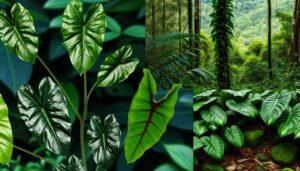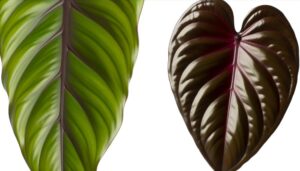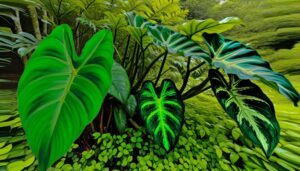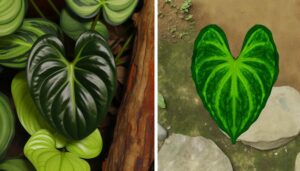Philodendron Melanochrysum Vs Micans: Key Differences!
Philodendron melanochrysum and Philodendron hederaceum var. micans, members of the Araceae family, each exhibit unique traits.
P. melanochrysum features elongated, velvety leaves reaching up to 36 inches, thriving in bright, indirect light and high humidity over 60%.
In contrast, P. micans has smaller, heart-shaped leaves with iridescent hues, suitable for lower light conditions and humidity between 50-70%.
Both species benefit from well-draining soil and precise watering to maintain best soil moisture. While P. melanochrysum prefers climbing, P. micans exhibits a trailing habit.
Continue exploring their nuances to understand their ideal care.
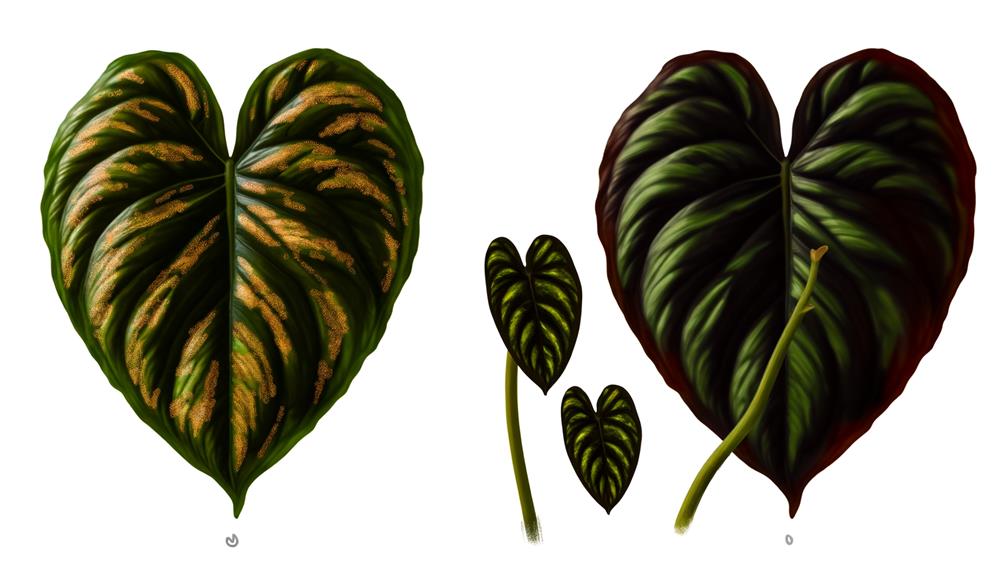
Key Takeaways
- Philodendron melanochrysum has large, elongated, velvety leaves, while Philodendron micans has smaller, heart-shaped, iridescent leaves.
- Philodendron melanochrysum prefers bright, indirect light, whereas Philodendron micans tolerates more shade.
- Philodendron melanochrysum exhibits a climbing habit, while Philodendron micans shows a trailing or vining growth pattern.
- Both species require well-draining soil but with different compositions: melanochrysum favors orchid bark, perlite, and peat moss.
- Humidity needs for melanochrysum exceed 60%, while micans thrive in 50-70% humidity levels.
Characteristic of Philodendron Melanochrysum vs Micans
| Characteristic | Philodendron Melanochrysum | Philodendron Micans |
|---|---|---|
| Leaf Shape & Texture | Long, heart-shaped leaves with a velvety texture and golden veins. | Smaller, heart-shaped leaves with a soft, velvety texture. |
| Leaf Color | Dark green to almost black leaves with golden veins. | Dark green with bronze or purple undertones and a soft sheen. |
| Growth Habit | Climbing plant, needs support to grow vertically. | Trailing or climbing vine, suitable for hanging baskets or trellises. |
| Size | Can grow large leaves up to 2-3 feet in length. | Smaller leaves, typically around 2-4 inches long, with a more compact size. |
| Light Requirements | Prefers bright, indirect light, but can tolerate lower light. | Thrives in low to medium indirect light, easy to adapt to most indoor spaces. |
| Care Difficulty | Requires moderate care, sensitive to overwatering and needs high humidity. | Easy to care for, ideal for beginners, and tolerant of various conditions. |
| Native Region | Native to tropical rainforests of Colombia and Ecuador. | Native to Central America and the Caribbean. |
Origin and Background
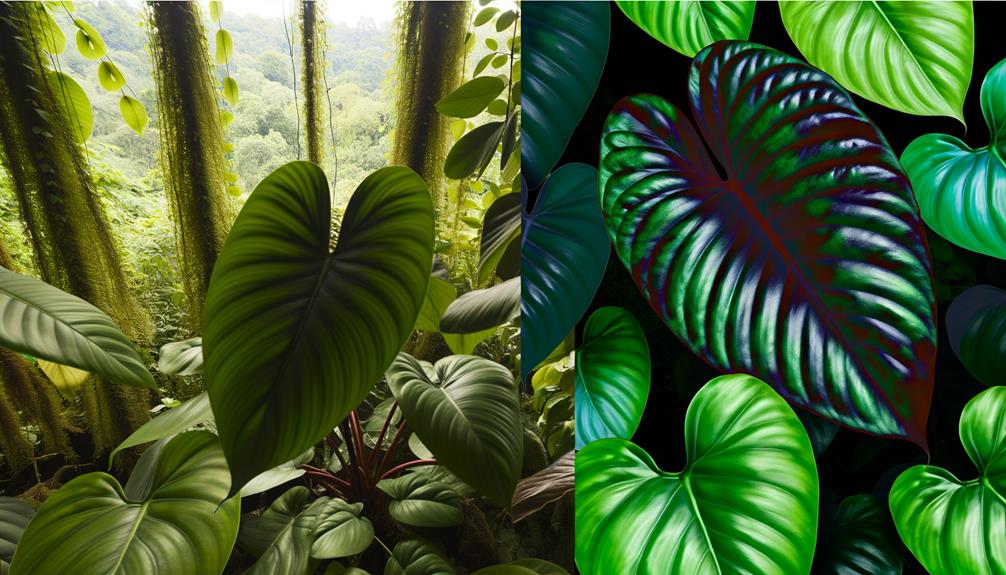
Philodendron melanochrysum and Philodendron hederaceum var. micans, both belonging to the Araceae family, originate from the tropical rainforests of Central and South America. These species are part of the extensive Philodendron genus, which encompasses over 400 species.
Philodendron melanochrysum, first described by H.W. Schott, thrives in the humid, shaded understory of the rainforest, where it climbs trees using its aerial roots. Conversely, Philodendron hederaceum var. micans, a variant of P. hederaceum, adapts well to various environmental conditions, making it prevalent in both lowland and montane forests.
Their natural habitats provide consistent humidity and temperature, fostering ideal growth conditions. Understanding these origins aids in replicating their native environment for successful cultivation.
Leaf Appearance
The leaf appearance of Philodendron melanochrysum and Philodendron hederaceum var. micans presents distinct morphological differences.
Philodendron melanochrysum exhibits larger, more elongated leaves with a velvety texture and pronounced vein patterns, often showcasing a dark green to almost black coloration.
In contrast, Philodendron hederaceum var. micans features smaller, heart-shaped leaves with a softer, velvety texture and iridescent hues ranging from green to bronze, accompanied by less prominent venation.
Color and Texture Differences
Leaf morphology reveals distinct differences in coloration and texture between Philodendron melanochrysum and Philodendron micans. Philodendron melanochrysum displays velvety, dark green to nearly black leaves with prominent, golden venation, giving a lavish appearance. In contrast, Philodendron micans exhibits a softer, velvety texture, with leaves shifting from bronze to deep green, often displaying a subtle iridescence. These differences in leaf appearance are crucial for taxonomic identification and cultivation preferences.
| Feature | Philodendron melanochrysum | Philodendron micans |
|---|---|---|
| Leaf Color | Dark green to black | Bronze to deep green |
| Venation | Prominent, golden | Subtle, less pronounced |
| Texture | Velvety, smooth | Velvety, iridescent |
| Appearance | Lavish, striking | Delicate, shimmering |
Understanding these distinctions aids horticulturists in selecting the appropriate species for their collections.
Shape and Size Comparison
Beyond coloration and texture, leaf morphology varies noticeably in shape and size between Philodendron melanochrysum and Philodendron micans.
Philodendron melanochrysum exhibits elongated, lanceolate leaves that can reach up to 24 inches in length under ideal conditions. These leaves are characterized by their velvety surface and pronounced pointed tips, contributing to their distinctive appearance.
In contrast, Philodendron micans has more diminutive, ovate-cordate leaves, typically measuring between 3 to 6 inches. The leaves of P. micans possess a softer, more delicate texture and a less pronounced pointed apex.
The difference in leaf size and shape between these two species underscores their unique adaptations and morphological diversity within the Araceae family, offering visual and horticultural interest to enthusiasts and researchers alike.
Vein Patterns and Details
Examining the vein patterns reveals significant distinctions between Philodendron melanochrysum and Philodendron micans, offering insight into their respective physiological adaptations.
Philodendron melanochrysum, known for its velvety texture, features prominent, white veins that contrast starkly with its dark green leaves. Conversely, Philodendron micans displays more subtle, reddish-brown veins that blend harmoniously with its bronze-toned foliage. These differences can be highlighted through several key observations:
- Philodendron melanochrysum: Pronounced white veins, creating a striking visual contrast.
- Philodendron micans: Reddish-brown veins, providing a muted, cohesive appearance.
- Melanochrysum leaves: Larger, heart-shaped, with a velvety surface.
- Micans leaves: Smaller, ovate, with a softer, more delicate texture.
Such vein patterns are integral to each species’ unique aesthetic and functional morphology.
Growth Habit
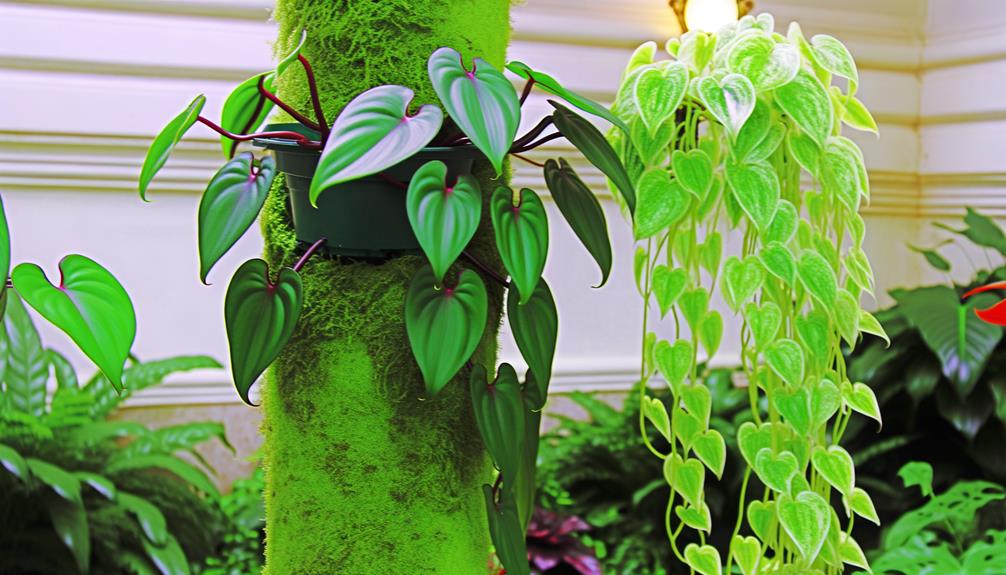
Philodendron melanochrysum and Philodendron micans demonstrate unique growth habits crucial for their identification and cultivation.
Philodendron melanochrysum, from the Araceae family, shows a climbing growth pattern with elongated, velvety leaves that can grow up to 36 inches long under ideal conditions. This species showcases internodal elongation that supports its epiphytic nature in native tropical forests.
In contrast, Philodendron micans, also part of the Araceae family, exhibits a trailing or vining growth style with smaller, heart-shaped leaves that typically stay within 8 inches. Its growth structure is more compact, with shorter internodes, making it suitable for hanging baskets or trellises.
Both species display distinct shapes adapted to their specific ecological habitats, thereby guiding their recommended cultivation methods.
Light Requirements
Philodendron melanochrysum and Philodendron hederaceum var. micans exhibit distinct responses to light conditions, important for best growth.
While P. melanochrysum thrives in bright, indirect light, P. micans demonstrates greater shade tolerance, adapting effectively to lower light levels.
Understanding these species-specific light requirements is necessary for maintaining their physiological health and promoting robust foliage development.
Optimal Light Conditions
Both Philodendron melanochrysum and Philodendron micans thrive in environments with bright, indirect light, which closely mimics the dappled sunlight of their native tropical understories.
Best light conditions for these species involve several critical factors:
- Intensity: Light should be bright but filtered, avoiding direct sunlight that can scorch delicate leaves.
- Duration: Approximately 10-12 hours of light per day replicates the natural photoperiod they experience in their habitats.
- Placement: Position plants near east or north-facing windows where light is abundant but indirect.
- Artificial Light: Full-spectrum grow lights can supplement natural light, especially in lower-light environments or during shorter days.
Understanding these precise requirements guarantees both species maintain their characteristic foliage and vibrant coloration, enhancing their ornamental value.
Shade Tolerance
Thriving in low-light environments, both Philodendron melanochrysum and Philodendron micans exhibit significant shade tolerance, which enables them to adapt effectively to less illuminated interior spaces.
Philodendron melanochrysum, belonging to the Araceae family, demonstrates its adaptive morphology through elongated, velvety leaves that maximize light absorption.
Philodendron micans, also an Araceae species, features iridescent, heart-shaped leaves that similarly optimize photosynthetic efficiency under subdued lighting conditions.
Both species possess chlorophyll configurations that enable efficient light capture even at lower intensities, highlighting their capacity for photophilous adaptation.
Consequently, these taxa are well-suited for cultivation in dimly lit environments, making them ideal for indoor horticulture enthusiasts seeking resilient, low-maintenance foliage plants that thrive in indirect or artificial light.
Watering Needs
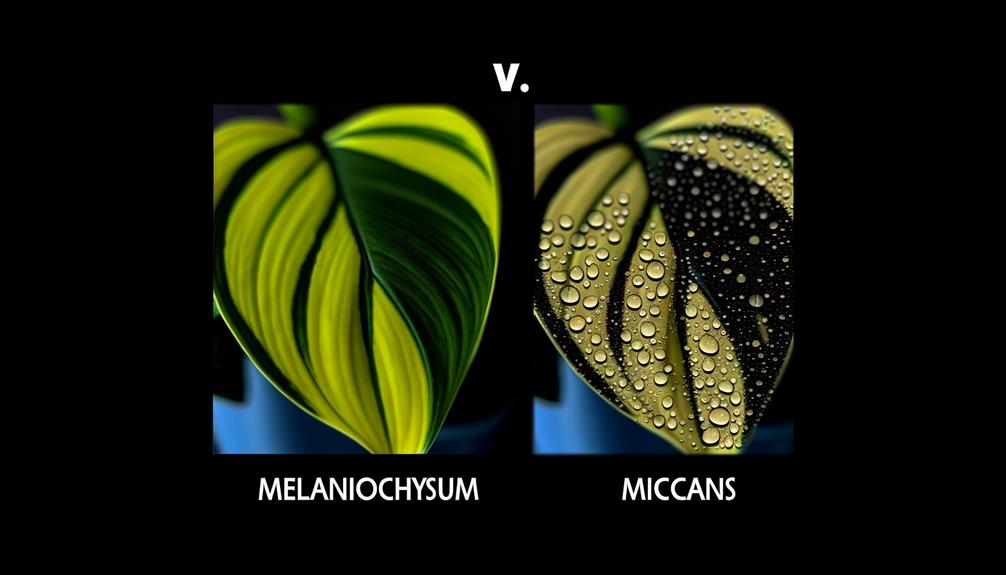
Ensuring ideal hydration for Philodendron melanochrysum and Philodendron hederaceum var. micans necessitates a nuanced understanding of their respective moisture requirements. Both species prefer consistently moist but well-draining substrates, yet exhibit subtle differences in best watering practices.
- Philodendron melanochrysum: Flourishes with consistent moisture levels; avoid waterlogging to prevent root rot.
- Philodendron hederaceum var. micans: Tolerates slight drying between waterings; sensitive to overwatering.
- Watering Frequency: Melanochrysum typically needs water more frequently, approximately once a week, whereas Micans may thrive with bi-weekly watering.
- Observation of Foliage: Wilting or yellowing leaves serve as indicators of improper hydration for both taxa.
Understanding these specific hydration needs promotes robust growth and essentiality for these philodendrons.
Soil Preferences
Ideal soil composition for Philodendron melanochrysum and Philodendron hederaceum var. micans is crucial for their physiological health, requiring substrates that balance aeration, moisture retention, and nutrient availability.
Philodendron melanochrysum thrives in a well-draining, chunky mix comprising orchid bark, perlite, and peat moss, facilitating prime root respiration and preventing waterlogging.
Philodendron hederaceum var. micans, while also favoring well-draining soil, benefits from a slightly finer texture, incorporating a blend of potting soil, perlite, and coconut coir.
Both species require substrates that maintain moderate moisture levels without becoming excessively saturated, thereby ensuring sufficient oxygen availability to the root zone.
Regular assessment of soil structure and amendment with organic matter enhances nutrient density and supports robust growth.
Temperature Tolerance
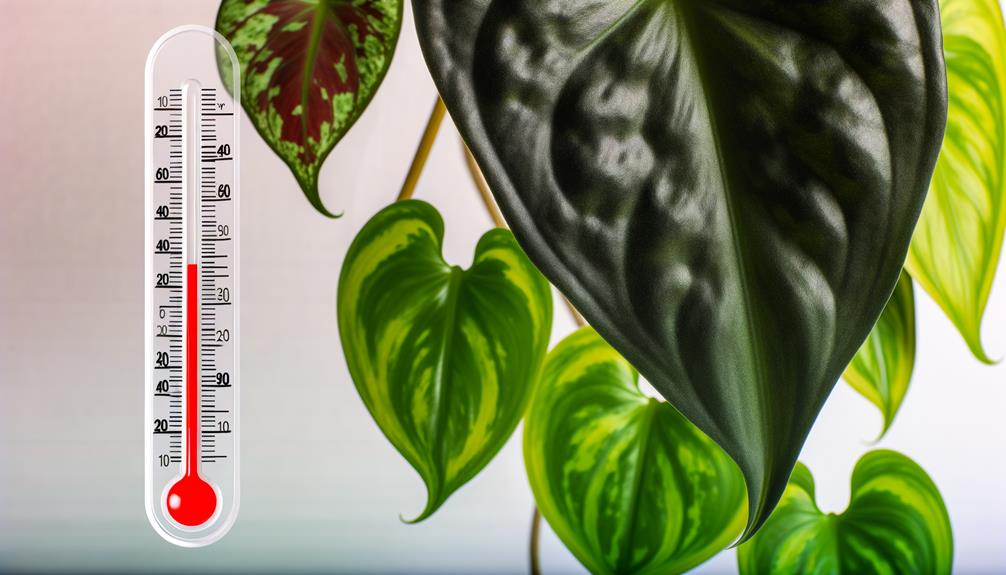
Ideal soil composition is only one aspect of successful cultivation; both Philodendron melanochrysum and Philodendron hederaceum var. micans also exhibit distinct temperature tolerance ranges that are crucial to their physiological health.
- Philodendron melanochrysum thrives in a temperature range of 65-80°F (18-27°C), where it maintains peak metabolic functions.
- Philodendron hederaceum var. micans prefers slightly cooler conditions, favoring 60-75°F (16-24°C) for optimal growth.
- Both species exhibit reduced photosynthetic activity below 55°F (13°C), leading to stunted growth.
- Temperatures exceeding 85°F (29°C) can induce heat stress, resulting in wilting and chlorosis.
Understanding these temperature preferences guarantees the maintenance of homeostasis and promotes robust vegetative and reproductive growth in these taxa.
Humidity Levels
Humidity levels play a vital role in the physiological well-being of both Philodendron melanochrysum and Philodendron hederaceum var. micans, with each species exhibiting a preference for high ambient moisture to sustain ideal growth conditions.
Philodendron melanochrysum, characterized by its velvety, dark green foliage, thrives in environments with humidity levels exceeding 60%, which is essential for best photosynthetic activity and foliage development.
Similarly, Philodendron hederaceum var. micans, known for its iridescent, heart-shaped leaves, necessitates humidity levels between 50-70% to maintain turgor pressure and prevent desiccation. Insufficient humidity can lead to less than ideal growth, leaf curling, and reduced physiological function in both taxa.
Hence, maintaining adequate humidity is indispensable for their cultivation and overall health.
Propagation Methods

Propagation of Philodendron melanochrysum and Philodendron hederaceum var. micans primarily employs stem cuttings, providing effective clonal reproduction. Techniques involve selecting healthy nodes and internodes, incorporating both aerial roots and leaf buds to maximize rooting potential.
Water propagation serves as an auxiliary method, fostering root development in a controlled, aqueous environment before transplantation to soil.
Stem Cuttings Technique
When propagating Philodendron melanochrysum and Philodendron micans, utilizing stem cuttings proves to be an effective technique owing to its ability to replicate the parent plant’s genetic and phenotypic characteristics. This approach guarantees the preservation of desirable traits in both species.
To execute stem cuttings, follow these methodical steps:
- Select a healthy stem: Identify a vigorous stem with at least one node and aerial root.
- Cut the stem: Use sterilized pruning shears to make a clean cut below the node.
- Prepare the cutting: Remove any lower leaves to minimize water loss and decay.
- Plant the cutting: Place the cutting in a well-draining substrate, ensuring the node is buried.
This meticulous process enhances propagation success rates for both Philodendron species.
Water Propagation Tips
To enhance the propagation success of Philodendron melanochrysum and Philodendron micans using water, confirm the cuttings are placed in a sterile, transparent container filled with distilled water to prevent contamination and promote root development.
Confirm the cuttings include at least one node, as this is the site of root emergence. Position the cuttings so that the node is submerged, while the leaves remain above water to facilitate photosynthesis.
Maintain water quality by replacing it weekly and keeping the container in indirect light to optimize growth without causing phytotoxicity. Monitoring the cuttings for signs of root initiation, typically within 2-4 weeks, will help in early detection of any issues and ensure healthy propagation.
Common Pests
Philodendron melanochrysum and Philodendron micans are frequently plagued by common pests such as spider mites (Tetranychus urticae), aphids (Aphidoidea), and mealybugs (Pseudococcidae). These pests can significantly impact the health and aesthetic quality of these plants.
- Spider Mites (Tetranychus urticae) – These arachnids spin fine webs and cause stippling on leaves, leading to chlorosis.
- Aphids (Aphidoidea) – Small, soft-bodied insects that cluster on new growth, causing deformation and excreting honeydew.
- Mealybugs (Pseudococcidae) – White, cottony pests that feed on plant sap, leading to weakened plants and sooty mold production.
- Scale Insects (Coccoidea) – Hard-shelled pests that attach to stems and leaves, extracting nutrients and causing yellowing.
Effective management includes regular inspection, isolation of infested plants, and appropriate pest control methods.
Choosing the Right Plant
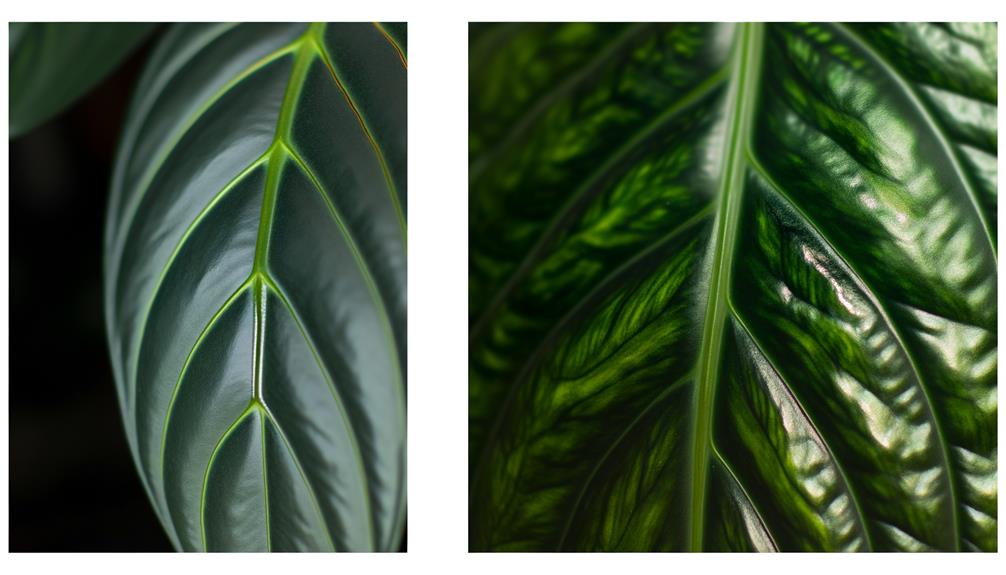
Selecting the most suitable plant for your environment involves evaluating the specific growth requirements and aesthetic qualities of Philodendron melanochrysum and Philodendron micans. Philodendron melanochrysum, known for its velvety, dark green leaves with golden veins, typically requires higher humidity and indirect light. Conversely, Philodendron micans, with its heart-shaped, velvety leaves that exhibit a bronze undertone, adapts better to lower light conditions and moderate humidity.
| Feature | Philodendron melanochrysum | Philodendron micans |
|---|---|---|
| Light Requirements | Indirect bright light | Low to moderate light |
| Humidity | High (60-80%) | Moderate (40-60%) |
| Leaf Texture | Velvety, dark green | Velvety, bronze undertone |
| Growth Habit | Climbing/vining | Climbing/vining |
| Ideal Temperature | 18-27°C (65-80°F) | 16-24°C (60-75°F) |
Choose based on these parameters to ensure optimal growth and aesthetic satisfaction.
Conclusion
To sum up,
Philodendron melanochrysum and Philodendron micans, both belonging to the Araceae family, showcase clear variations in leaf morphology, growth habits, and environmental needs.
While P. melanochrysum’s larger, velvety leaves differ from P. micans’ smaller, heart-shaped foliage, these distinctions impact their maintenance requirements and adaptability to different indoor settings.
Which species is more suitable for a particular environment? Grasping these plant-specific differences helps in choosing the right philodendron based on preferred aesthetics and care requirements.

